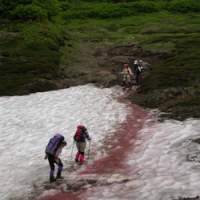As the heat and humidity of summer build up, my favored relief is to head for the hills. Last weekend I even managed to slide down a snowbank, and that really cooled me off!
Snow lingers late in the higher mountains here in Hokkaido where I live, and the snowbanks make fascinating environments to visit at this time of year. Each acts like a kind of time machine -- spring arrives earliest where the snow first melts, and arrives later and later toward the middle of the snowbank as it slowly melts away. So, approaching a snowbank in high summer is literally like walking back through time from midsummer (at the greatest distance), to early summer, late spring and then early spring as you reach the edge of the bank -- and, of course, winter where the snow still remains.
Looking closely at the snow itself, you may even find some bizarre red areas known as "watermelon snow." These are caused by the presence of a cryophilic (cold-loving) green algae rich in a bright-red carotenoid pigment. Walk across the snow where this is growing and it garishly looks as if you are leaving a trail of bloody footprints.
If you turn your back on the snowbank, and walk away from it, you find plants just pushing out their first shoots, while a few meters on they are in bud, further out in flower, and then, right away from the snowbank, they have already gone to seed. Last weekend, in the Daisetsu Mountains here in Hokkaido, I managed to find mountain avens from the rose family in all these stages in just a matter of 50 meters.
A summer visit to the alpine zone, which is possible even by road if you drive over some high passes in the Japan Alps, makes for a cool experience; the flowers above the tree line are really neat, and so different from anything at lower altitudes. Plants in the alpine zone are really on the edge: Adapted to live under extreme conditions, at the best of times theirs is a tough lifestyle -- and with global warming, their high-altitude range is coming under increasing threat.
Bogs with oligotrophic soils
Off the beaten track in the mountains, there is another fascinating habitat -- one of cool, peaty swamps or bogs with oligotrophic soils, which have very few nutrients. The plants living in these two very different environments face similar problems, so how do they survive?
If you go walking through such places along the obligatory boardwalk with your head held high, you'll miss some of the gems that make a home here. Find a quiet spot, get down on your hands and knees, and literally grovel close to that wet, acidic soil -- it is the only way to enjoy some of the tiny and amazingly fragile-looking species living there.
Once you get used to the perspective, you may also find some strangely glistening, little red leaves -- typically in a tight rosette on the surface of the wet soil. If you are lucky, you may even come across a thin, 10- to 15-cm-tall flower stalk, at the top of which are such tiny white flowers that they are really hard to spot.
On closer inspection (if you have binoculars, flip them over and use them as a microscope), the red leaves reveal a bizarre approach to surviving with a shortage of nutrients. If there is insufficient food available through your roots, what do you do? You catch some.
Yes, these little sticky-leaved plants are carnivorous members of the sundew family in the genus Drosera. From tiny stalked, hairlike glands on their leaves, they secrete drops of a glistening, sticky juice (hence the name sundew) that lures and then ensnares mosquitoes, gnats and midges, which become food for the plant.
But don't let these plants' diminutive stature fool you; this is a very successful group of flora that occurs around the world other than in Antarctica. I have seen them from Scotland to Hokkaido, and from Alaska to New Zealand; they live just about wherever there are poorly drained oligotrophic soils. They live a split-level existence -- with low-level leaves trapping food and high-rise flower stalks luring insects for pollination. By raising their flowers high into the air, they reduce the likelihood that they will trap pollinators.
Their sticky entrapment glands aren't the whole of the remarkable story of sundews. They are thigmotropic, too, meaning that their leaves are sensitive to touch. Once an insect is stuck on them, the leaves bend in toward the center to bring more and more sticky-tipped hairs into contact with the creature. These same glands secrete enzymes that serve to dissolve the insect so the leaf can absorb the resulting nutrient soup to fuel further growth. Sounds gruesome, but it's all in a sundew's day's work.
In contrast to the acidic wet soils of bogs and swamps where the sundews grow, the alpine zone of the higher mountains seems a world apart. Yet the soils in alpine zones share, in their dearth of nutrients, similarities with the boggy soils of oligotrophic marshes and wetlands. There, the endlessly repeated freeze-thaw process tends to lead to rather open, loose soils that are easily leached of their nutrients by the throughflow of water.
Plant life in the alpine zone is also exposed to powerful, desiccating winds, strong ultraviolet light and low temperatures for a large part of the year and at night. It's amazing really that anything can thrive.
Typical alpine plants grow in a dense mat formation with their leaves clustered low. This allows them to exist in a ground-hugging microclimate, escaping the worst of the wind to create a warmer temperature than the surroundings -- like a penguin huddle, none really want to be on the outside, so the mats tend not only to be low, but round.
Being low down has its advantages -- but not if you want to attract a passing bumblebee or fly to pollinate your flowers. So here, too, we find split-level living. Alpines often throw up their flowers atop longish stalks, raising them so that insects can easily find them. Some even have another trick up their sleeves; attracting insects is one thing, but then they need to employ the very wind their form has evolved to escape from to ensure dispersal of their seeds.
Best of both worlds
Some have achieved the best of both worlds. Plants such as mountain avens benefit from having their leaves in a ground-hugging rosette, but then they actually elongate their stems after pollination to allow the wind to carry off their feathery seeds all the more easily.
The strategies plants come up with to survive in some of the toughest environments, whether acid swamp or alpine meadow, really are amazing.





















With your current subscription plan you can comment on stories. However, before writing your first comment, please create a display name in the Profile section of your subscriber account page.